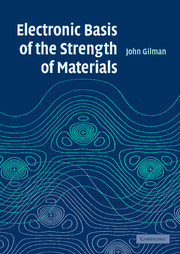Book contents
- Frontmatter
- Contents
- Preface
- Section I Introduction
- Section II Elements of solid mechanics
- Section III Elements of electron mechanics
- Section IV Elastic stiffness
- Section V Plastic strength
- 16 Macroscopic plastic deformation
- 17 Microscopic plastic deformation
- 18 Dislocation mobility
- Section VI Fracture resistance
- Index
- References
18 - Dislocation mobility
Published online by Cambridge University Press: 14 August 2009
- Frontmatter
- Contents
- Preface
- Section I Introduction
- Section II Elements of solid mechanics
- Section III Elements of electron mechanics
- Section IV Elastic stiffness
- Section V Plastic strength
- 16 Macroscopic plastic deformation
- 17 Microscopic plastic deformation
- 18 Dislocation mobility
- Section VI Fracture resistance
- Index
- References
Summary
Introduction
Since dislocations “multiply” as they move (i.e., they increase their length), and since they are almost always present initially in structural materials, their most important property is their mobility. If this is very small, as it is in covalently bonded crystals like silicon at temperatures below the Debye temperature (about 920 K in Si), the material is brittle, tending to fracture before it deforms plastically. If the mobility is large, as it is in nearly perfect gold, or copper, crystals, then the material is very ductile, or malleable. Such crystals may be hammered violently without fracturing them.
The range of dislocation mobilities is very large as measured by the stress needed to move a dislocation at an observable rate in a laboratory experiment. This range starts at zero in a nearly perfect metal, and ends at about G/4π in a covalent crystal, where G is the appropriate shear modulus (G of the (111) plane is about 5 Mbar for diamond). At the high end of this range, the velocity is proportional to the applied stress so the mobility is liquid like, and the material has no intrinsic barrier to dislocation motion (if finite barriers are observed, i.e., finite yield stresses, they result from extrinsic factors). At the low end of the range, the mobility is intrinsic, determined by the chemical structure of the crystal.
The extrinsic factors that create finite yield stresses are numerous.
- Type
- Chapter
- Information
- Electronic Basis of the Strength of Materials , pp. 201 - 246Publisher: Cambridge University PressPrint publication year: 2003



